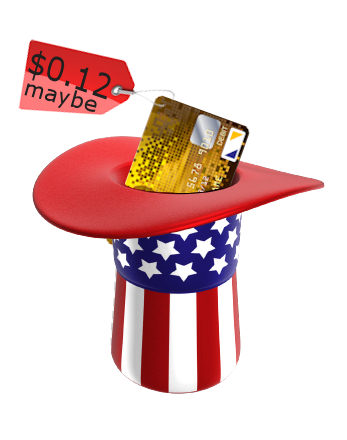
 On December 16, the Federal Reserve Board proposed a new rule that would lower by as much as 84 percent the $16.2 billion in fees that merchants pay annually when you swipe your debit card at their cash registers. (The Fed asked for public comments on the proposal by February 22, 2011.) The idea is that merchants will save money and pass along savings to you.
On December 16, the Federal Reserve Board proposed a new rule that would lower by as much as 84 percent the $16.2 billion in fees that merchants pay annually when you swipe your debit card at their cash registers. (The Fed asked for public comments on the proposal by February 22, 2011.) The idea is that merchants will save money and pass along savings to you.
Immediately, large U.S. banks and credit card issuers attacked the proposed rules as a threat to their industry, a handout to merchants who get out of paying their fair share of money network costs, and a booby-prize for consumers who gain no assurance of savings but almost surely would face higher banking fees. (See "Debit Card Fee Cap Could Mean Higher Prices for Consumers").
Behind the proposed new rules and the arguments against them are some key questions: Why should you care? What are the real costs? Who should pay?
Why Care?
According to the Fed, debit card use in the United States now exceeds all other forms of noncash payments. The interchange fee that merchants pay when you use your debit card is largely hidden from you, but it funds a network of technology and services that ensure you can trust using your debit card without risking your bank account. Like all infrastructure, this network requires money to build, maintain, operate and improve. Banks will not operate these networks for free, so if merchants pay less, it's likely that you will pay more, either directly or indirectly, to use your debit cards.
What does it cost to operate?
The new Fed proposal caps the fee for running a debit card transaction at between 7 and 12 cents, a huge reduction from the average of 44 cents per transaction charged currently. That's the Fed's estimate of costs. The real costs are much harder to measure.
These technology costs are fairly easy to estimate. No physical money actually moves when you swipe your debit card at the store. Only digital information gets exchanged between the merchant's bank and your bank. In this way, the debit card network is kind of like the wireless phone network that carries text messages from phone to phone.
What's difficult to measure is the cost of security, reliability and exception handling. If money was lost or misrouted at the same rate as text messages, we would all be stashing hard cash under our mattresses. For reliability, the banks use debit networks operated by Visa, MasterCard and others, and they are good. Even during the week before Christmas, the networks route card transactions from anywhere in the world to anywhere else in under two seconds. More importantly, the network operators handle problems. You can't unsend a text message, but you can reverse a debit payment. And you can get help on the phone when you need it. Although banks' customer service isn't always perfect, the rules and processes for handling mistaken or fraudulent card transactions work well enough for us to trust the banks with our money.
The reason it's hard to measure support costs when there's a problem is that no fewer than three parties are involved: the merchant's bank, your bank, and the payment network in the middle. Unlike the decreasing costs of transmitting bits of information across digital networks, the human-intensive costs of managing fraud risks and providing customer support have increased. Factoring the human costs across three levels of intermediaries is very nearly impossible.
Who should pay? And how much?
It's good to pry open the debit card to improve transparency and foster more competition. But I was surprised that the Fed picked such a low range -- 7 to 12 cents -- as an interchange cap while admitting that it had not considered all aspects of the problem (such as customer support costs) and was not sure if it would serve the interest of consumers. The proposed cap is not a good first step. It will surely ignite an endless debate by less-than-candid incumbents about why the chosen number is wrong. It also avoids the question of who will pay the debit network operating costs if the merchants don't do so? The banks aren't interested in losing money, so it's reasonable to assume the consumers would pick up the merchant's share by some means or another.
I'm curious about a different approach based on positive pricing and transparency. Today, banks use a form of negative or "penalty pricing" in which they offer you "free" checking accounts and debit cards but make money from your mistakes in the form of overdraft fees and such. Instead of penalizing you for mistakes, what if banks offered a menu of services that you chose to pay for upfront, including a small price for using your debit card? You could shop around for the best deals and know you're not going to get hit with hidden fees. It would help fund the cost of operating debit networks while relieving merchants -- many of them small, local stores - of bearing the full cost of the network.
There are complications to a positive pricing approach, but overall, letting you see what you're actually paying and giving you the choices must be better than meddling with behind-the-scenes fees in ways that you'll probably end up paying for anyway.
Disclosure: I am CEO of Plastyc, a company that offers prepaid card services (prepaid cards are a sub-category of debit cards). My company is not directly affected by the proposed interchange rules, which only apply to prepaid card issuers with assets of $10 billion or more.